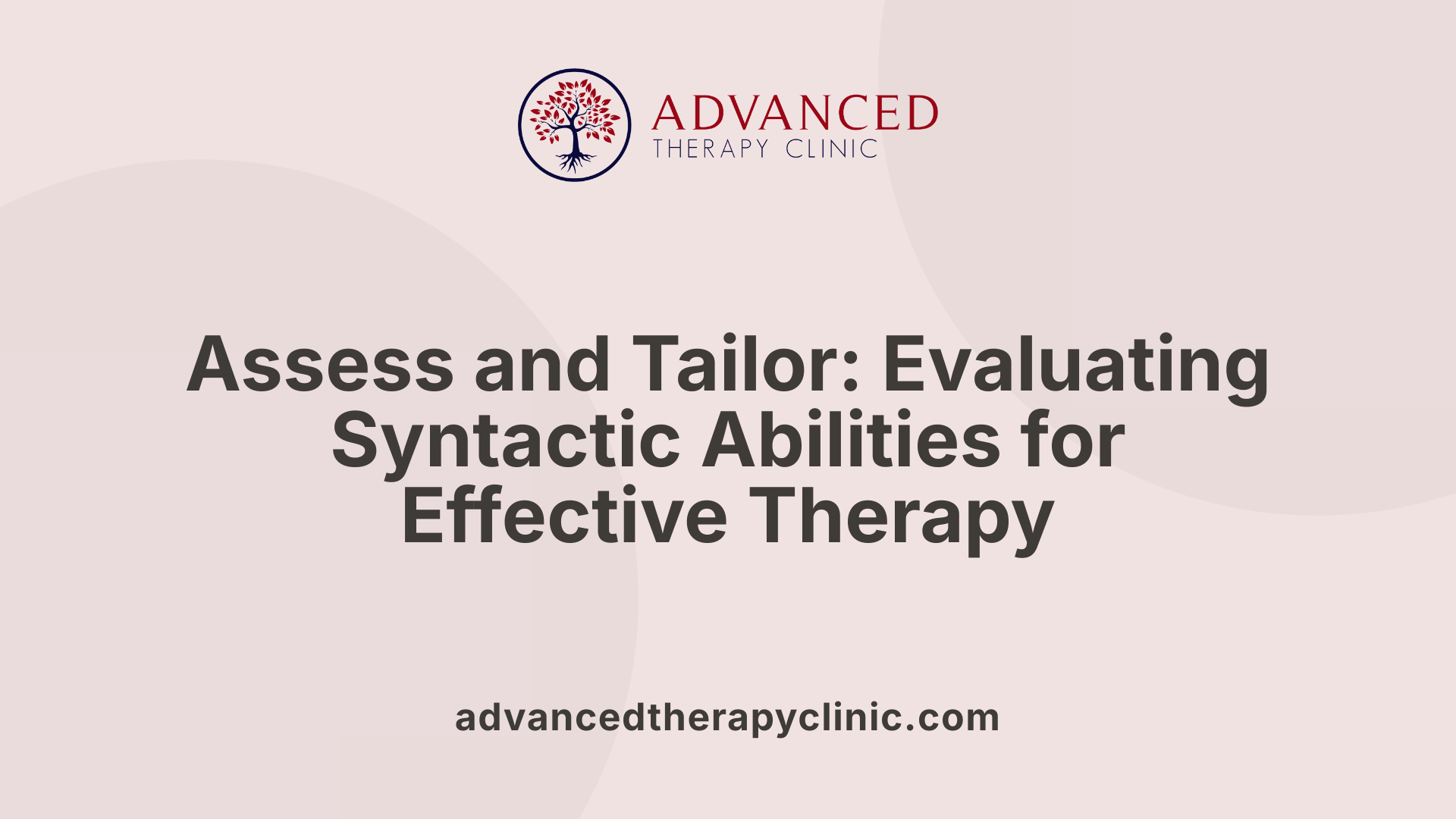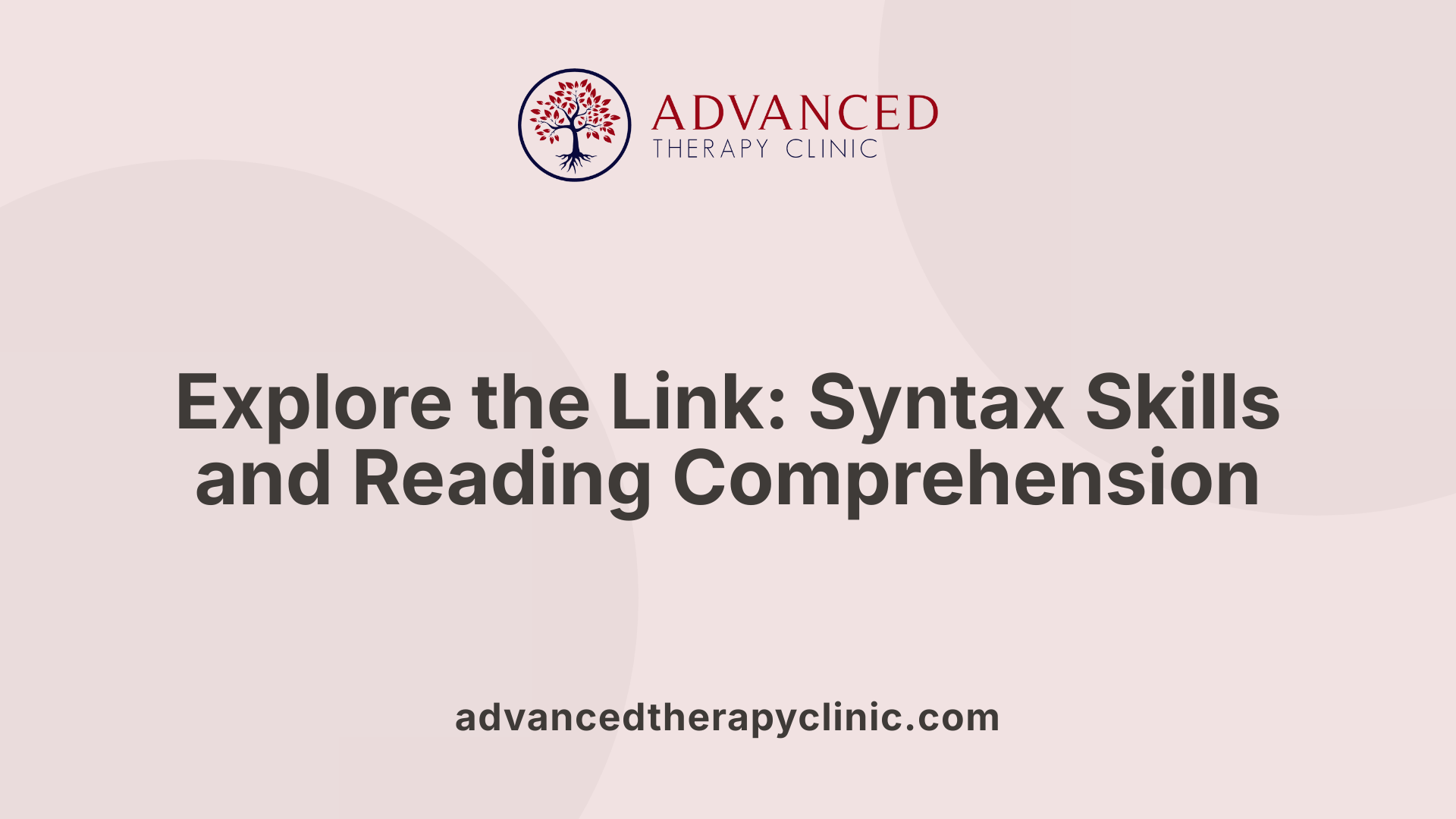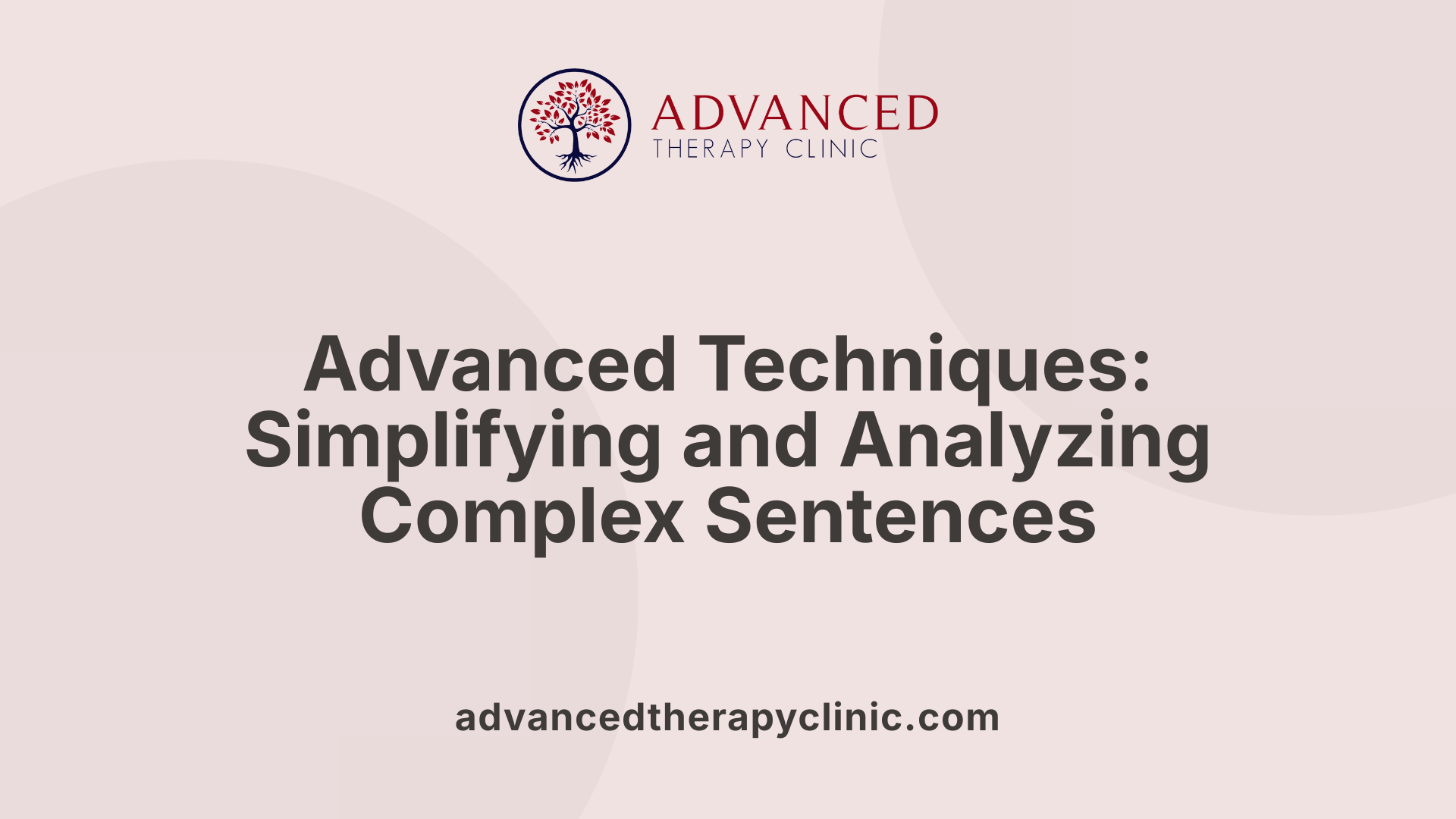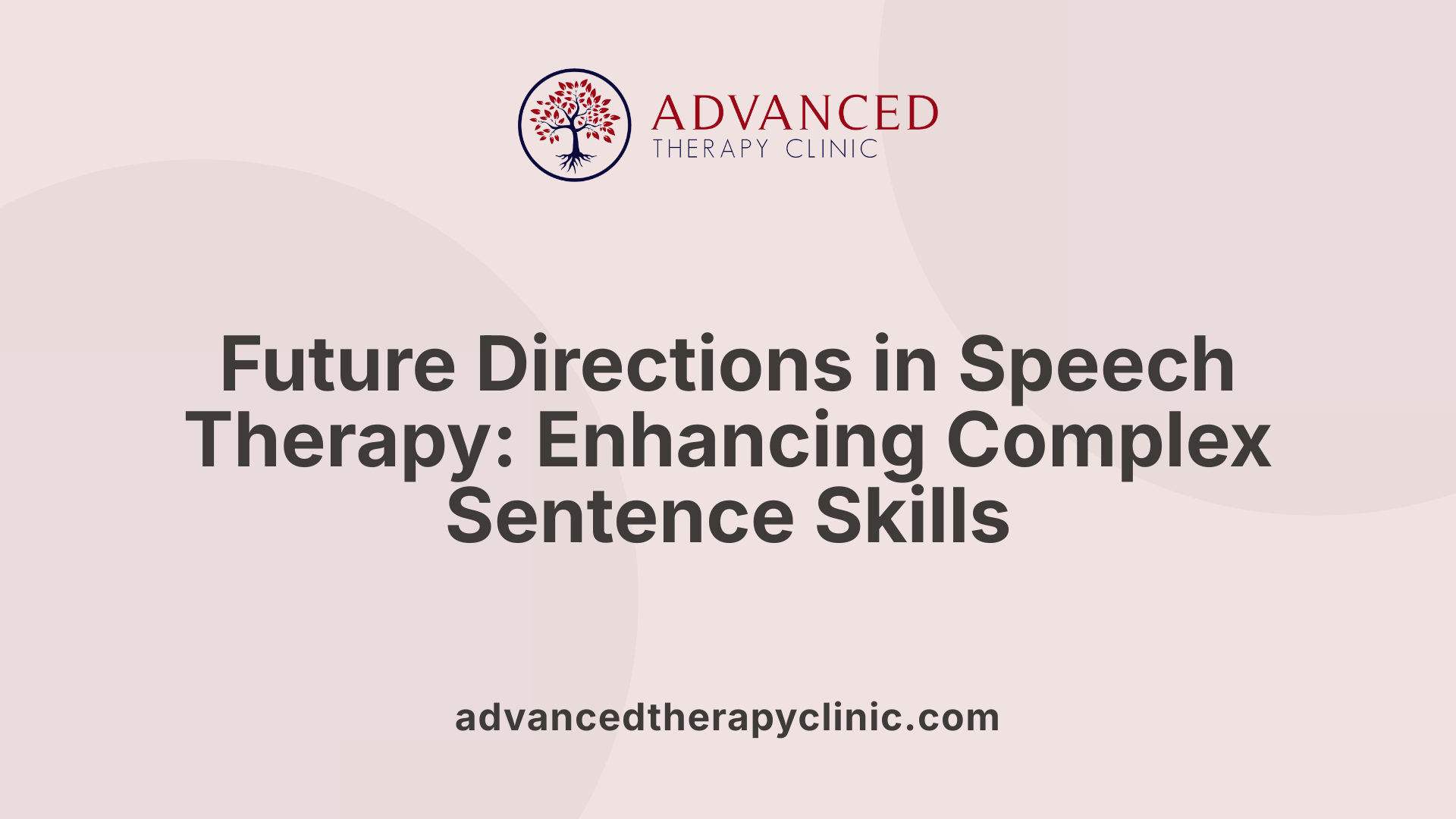How Speech Therapy Assists with Comprehending Complex Sentences


Understanding the Importance of Complex Sentences in Speech Therapy
Complex sentences are foundational to effective communication and academic success, yet they pose significant challenges for children and adolescents with developmental language disorders (DLD). Speech therapy plays a critical role in helping these individuals improve their comprehension and production of complex sentence structures, which can profoundly affect their overall language skills, reading comprehension, and writing abilities. This article explores how targeted speech therapy interventions address these challenges, enhancing syntactic awareness and promoting functional language improvements.
Defining the Spectrum of Therapy-Related Fields
What are the main types of therapy included under the collective term for various therapy-related fields?
Therapy-related fields encompass a broad spectrum of approaches designed to support physical, emotional, behavioral, and mental well-being. Psychotherapeutic methods, such as cognitive-behavioral therapy (CBT), dialectical behavior therapy (DBT), psychodynamic therapy, acceptance and commitment therapy (ACT), and humanistic therapy, primarily focus on mental health and emotional regulation.
In addition to these, supportive and rehabilitative therapies play essential roles. These include physical therapy and occupational therapy, which aid recovery of bodily function and daily living skills. Speech therapy is a critical component aimed at improving communication abilities, addressing speech, language, cognitive-communication, voice, and fluency disorders.
Moreover, applied behavior analysis (ABA) targets behavioral challenges, often in developmental disorders, while nutrition therapy supports health through dietary management. Collectively, these varied therapeutic approaches form an integrated framework dedicated to enhancing an individual's overall health and quality of life across multiple domains.
The Challenge of Complex Sentences for Children with Developmental Language Disorders
What difficulties do children with DLD face with complex sentences?
Children with developmental language disorders (DLD) often struggle to understand and produce complex sentences. This difficulty arises because complex sentences involve more intricate syntactic structures than simple sentences, making it harder for these children to grasp the intended meaning and reproduce the sentences accurately.
What are examples of challenging structures like passive voice and embedded clauses?
Notable examples of complex sentence structures that pose challenges include the passive voice, where the usual order of subject and object is reversed, and embedded clauses, which are clauses nested within other clauses. For instance, sentences like "The ball was thrown by the boy" (passive voice) or "The book that the girl read was exciting" (embedded clause) require more advanced syntactic processing.
How does cognitive load affect processing complex syntax?
Processing complex syntax places a higher cognitive load on children with DLD. The mental effort required to parse and integrate multiple clauses or non-standard sentence forms can overwhelm their linguistic and working memory capacities. This increased cognitive demand leads to greater difficulties in comprehension and production of such sentences, contributing to challenges in academic language tasks.
Overall, the combination of syntactic complexity and cognitive load significantly impacts children with DLD, underscoring the need for targeted speech-language interventions that address these specific challenges.
The Importance of Targeting Complex Sentences in Speech Therapy
Why Are Complex Sentences Important for Language Comprehension and Academic Success?
Complex sentences, which involve structures such as relative clauses, embedded clauses, and passive voice, play a crucial role in advancing a child's language comprehension and production. These sentence forms help express detailed ideas and relationships between concepts, which are fundamental for understanding academic texts. Children and adolescents with developmental language disorders (DLD) often struggle with these sentences, facing increased difficulty especially when processing sentences that require greater cognitive effort. Enhancing their ability to understand and produce complex sentences directly supports academic outcomes by improving their grasp of the language used in educational settings.
How Are Syntax and Reading/Writing Skills Connected?
Syntax—the arrangement of words and phrases to create sentences—is deeply intertwined with reading comprehension and writing abilities. Children with language disorders often show syntactic delays that can negatively impact their reading and writing. Understanding syntactic structures empowers learners to decode text more efficiently and organize their written thoughts coherently. Research has established that knowledge of sentence structures influences reading comprehension across early childhood and school years, beyond vocabulary and memory skills. Complex sentence structures found in academic texts particularly affect readability and comprehension for struggling students.
What Role Does Syntactic Development Play in Speech Therapy?
Speech therapy for children with DLD frequently targets syntactic development to improve both language comprehension and production. Techniques such as priming, modeling, recasting, and sentence combining help develop awareness and mastery of complex sentences. These methods not only promote syntactic skills but also support oral reading fluency and writing competence. Incorporating syntactic focus into therapy, especially in natural academic contexts, bridges language intervention with real-world application. Teaching activities might include analyzing sentence structures, practicing sentence combining with conjunctions, and explicitly discussing function and form of complex clauses.
By emphasizing complex sentence structures through targeted interventions, speech therapy can significantly enhance both linguistic and academic performance among children with developmental language issues.
Key Speech Therapy Techniques for Improving Complex Sentence Comprehension

Priming, modeling, and recasting
Priming, modeling, and recasting are foundational techniques used in speech-language therapy to support children and adolescents with developmental language disorders (DLD). Priming involves exposing the learner to target sentence structures prior to production tasks, which facilitates quicker and more accurate sentence formation. Modeling provides clear examples of complex sentences, allowing learners to hear and imitate correct syntactic forms. Recasting repairs or reformulates a child's incorrect sentence by restating it correctly, encouraging implicit learning without direct correction. Together, these methods gradually improve both comprehension and production of sentences involving passive voice, embedded clauses, and other complex constructions.
Contextualization and metalinguistic instruction
Embedding complex sentence training within meaningful contexts enhances generalization to real-life academic settings. Contextualization links sentence exercises to relevant discourse and texts, making language targets more engaging and functional. Metalinguistic instruction raises students’ awareness of sentence components and structures beyond intuitive use. It involves explicit discussion about sentence parts, grammar rules, and syntax, which helps learners analyze and manipulate language. This instruction can increase syntactic understanding, promote better reading comprehension, and support writing skills by providing tools to decode and create complex sentences in varied contexts.
Sentence combining and its benefits
Sentence combining is an effective, feasible technique frequently employed in therapy sessions focused on syntactic development. It involves presenting simple, related sentences and guiding students to combine them using conjunctions and other linking devices to form complex or compound sentences. This step-by-step process, using materials like dry erase boards, markers, and conjunction lists, builds students’ skills in creating longer, more sophisticated sentence structures. Beyond improving syntactic skills, sentence combining also enhances language comprehension and writing abilities by fostering a deeper understanding of how ideas and clauses connect within a sentence. As children advance, this approach supports progression from simple and compound sentences to more complex constructions essential for academic success.
Sentence Combining: A Practical and Effective Intervention
Step-by-step protocol for sentence combining
Sentence combining is a structured activity where simple related sentences are merged into longer, more complex ones. The process starts by selecting related simple sentences appropriate for the child's current level. Next, suitable conjunctions are introduced—these could be coordinating conjunctions like and, but, or or, or subordinating conjunctions for more complex structures. Finally, students are guided to combine these sentences, creating compound or complex sentences that reflect accurate syntax and meaning.
Use of conjunctions to form compound and complex sentences
Conjunctions play a critical role in sentence combining. Coordinating conjunctions help combine independent clauses into compound sentences, while subordinating conjunctions introduce dependent clauses, forming complex sentences. For example, because, although, and when introduce clauses that add depth but also increase sentence complexity. Teaching students to use these connectors appropriately enhances both syntactic complexity and coherence in their language production.
Materials and customization for therapy sessions
Materials needed for sentence combining exercises include pencils, markers, paper, dry erase boards, and lists of conjunctions. These resources can be customized based on the student's interests and language goals to maintain engagement and relevance. Simple sentences used during therapy should be tailored to the child's level and expanded gradually to include more complex structures as their skills develop.
Benefits on syntactic skills, comprehension, and writing
Research shows that sentence combining improves syntactic skills by encouraging awareness of sentence structure and sentence length. This improvement extends to better language comprehension and writing abilities. By practicing how to join sentences effectively, children develop stronger oral and written communication. Additionally, these gains can support reading comprehension, as understanding complex sentences is crucial for processing academic texts. Sentence combining is thus a feasible and impactful technique within speech-language therapy for children with developmental language disorders.
Embedding Complex Sentences Within Academic Contexts
Why Use Naturalistic Academic Contexts for Therapy?
Embedding complex sentence training within natural academic contexts offers a vital bridge between speech-language therapy and everyday language use. Children and adolescents with developmental language disorders (DLD) face significant challenges in both understanding and producing complex sentences, especially those that appear in academic settings involving passive voice and embedded clauses. By situating intervention activities in meaningful school-related scenarios, therapy can directly address the language demands these students encounter daily.
How Does this Approach Bridge Language Intervention and Real-World Application?
Focusing on complex sentences in authentic academic discourse helps generalize gains made during therapy to broader functional communication skills. Although current evidence shows improvements in complex sentence production and comprehension following such interventions, long-term data supporting sustained functional language changes remains limited. Still, targeting complex syntax within contexts familiar to the child enhances motivation, relevance, and applicability of language skills beyond the therapy room.
What Role Do Discourse and Academic Texts Play in Promoting Generalization?
Incorporating discourse and texts relevant to academic activities facilitates deeper understanding and use of complex sentences. For example, therapy activities might involve reading, analyzing, and producing sentences from school texts, which inherently include noun phrase expansions, subordination, relative clauses, and adverbial clauses. This explicit instruction and practice within connected language promote syntactic awareness and support comprehension and production skills linked to academic success.
These methods ultimately aim to improve linguistic competence in contexts mirroring real classroom experiences, fostering better reading comprehension, oral language fluency, and writing abilities. Thus, complex sentence treatment rooted in academic content plays a crucial role in helping students with DLD meet the syntactic demands of their educational environment.
Assessing Syntactic Abilities to Inform Therapy

What assessment tools help evaluate syntactic abilities in children with DLD?
Speech-language therapists use a variety of assessment tools to evaluate syntactic skills in children and adolescents with developmental language disorders (DLD). Commonly used measures include sentence recall tasks, where the child repeats sentences of increasing complexity to gauge their syntactic memory and production. Sentence combining tasks require students to merge simple sentences into more complex constructions, directly targeting syntactic manipulation. Additionally, comprehension questions involving complex clauses assess understanding of sentence structures such as relative clauses and embedded clauses.
How do these assessments identify syntactic deficits affecting academic skills?
These syntactic assessments allow clinicians to detect specific difficulties with complex sentence comprehension and production, which often underlie challenges in reading and writing. For example, poor performance on tasks involving subordination or passive voice can explain why a child struggles with understanding academic texts or producing written language that requires varied syntax. Identifying these syntactic deficits is crucial as they often correlate with reduced reading comprehension and difficulties in writing development.
How can intervention be tailored based on assessment results?
Once syntactic weaknesses are pinpointed, interventions can be customized to target those particular sentence structures. For instance, if a child shows trouble with relative clauses, therapy might focus on modeling and practicing these forms using sentence combining and metalinguistic instruction. Tailored interventions also incorporate contextualized activities relevant to the child’s academic environment, which helps generalize skills to real-life language demands. Using assessment data to guide therapy ensures that goals address the child's unique needs, improving both oral language and literacy outcomes effectively.
Connection Between Syntax Knowledge and Reading Comprehension

How does syntax knowledge correlate with reading comprehension beyond decoding and vocabulary?
Research has shown a strong correlation between a child's understanding of syntax—specifically sentence structure—and their reading comprehension abilities. This relationship holds true even when factors such as decoding skills, vocabulary knowledge, and memory are taken into account. In other words, the ability to understand and manipulate complex sentences independently contributes to how well a student can grasp written texts. This highlights the importance of focusing on syntactic skills in speech-language therapy and educational practices.
What does research across different languages and age groups reveal?
Studies conducted in multiple languages including English, French, Dutch, and Cantonese demonstrate that the impact of syntax on comprehension is consistent from early childhood through K-12 education. These wide-ranging results confirm that syntactic knowledge is a universal contributor to language comprehension, regardless of linguistic or cultural differences. Such findings emphasize the need for targeted intervention across diverse populations and age groups to improve language outcomes.
How does sentence complexity affect readability and oral fluency?
Complex sentences, especially those found in academic texts, tend to increase syntactic complexity and pose significant comprehension challenges for students, particularly those with developmental language disorders (DLD). The complexity of sentence structures influences the readability of texts and directly impacts oral reading fluency—where proper prosody and sentence-level reading skills are vital. Incorporating explicit instruction on complex sentence structures and fluency-building exercises within speech therapy can improve both oral and written language proficiency.
These insights affirm that bolstering syntax knowledge through therapy methods such as sentence combining and focused sentence analysis is vital for enhancing reading comprehension and overall academic performance.
Intervention Outcomes: Improvements and Limitations
Evidence of Proximal Improvements in Complex Sentence Production
Speech-language therapy targeting complex sentence structures has demonstrated notable progress in children's and adolescents' ability to produce these sentences. Interventions utilizing methods such as priming, modeling, recasting, contextualization, metalinguistic instruction, and sentence combining effectively improve proximal outcomes. For example, sentence combining exercises guide students to combine simple sentences using conjunctions, enhancing their syntactic skills and promoting longer, more complex sentence production.
Positive Outcomes on Language and Reading Skills
Improved syntactic awareness through targeted intervention correlates with gains in both spoken and written language abilities. Research by Gillon and Dodd (1995) finds that approaches including sentence combining and sentence deconstruction can enhance reading comprehension and overall language performance. Teaching complex sentence structures such as relative clauses and adverbial clauses helps students navigate syntactic complexity in academic texts, supporting better reading and writing outcomes. Additionally, focusing on sentence complexity within academic contexts enhances generalization to real-world use.
Limitations Regarding Long-Term Functional Changes
Despite these promising proximal improvements, evidence for lasting functional gains remains limited. Studies highlight that while therapy can increase the production and understanding of complex sentences, there is less conclusive support for sustained improvements in everyday communication and academic achievement over time. Researchers recommend embedding complex sentence training within natural academic activities and discourse to promote broader generalization, though further rigorous investigation into long-term impacts is needed to confirm effectiveness beyond targeted therapy contexts.
Teaching Syntactic Awareness and Sentence Structures in Therapy
Focus on relative clauses, adverbial clauses, and noun phrase expansion
Speech-language therapy for children with developmental language disorders prioritizes the mastery of complex sentence structures such as relative clauses, adverbial clauses, and noun phrase expansion. These structures help increase syntactic complexity, but they can also pose significant comprehension challenges, especially when encountered in academic texts. Developing skills in these areas supports not only oral language proficiency but also reading comprehension and writing capabilities, which are commonly affected in children with language disorders.
Explicit instruction methods
Effective therapy involves explicit instruction that guides students through understanding and producing these complex sentence forms. Techniques like metalinguistic instruction explain the roles and functions of different clause types, while modeling and recasting help demonstrate correct usage in natural contexts. Contextualization situates sentence structures within meaningful discourse, enhancing relevance and engagement. These methods boost both syntactic awareness and the practical ability to use complex sentences.
Activities like paraphrasing and targeted comprehension questions
Practical activities are essential for reinforcing syntactic skills. Paraphrasing tasks encourage students to restate sentences using different syntactic forms, deepening their understanding of sentence construction. Targeted comprehension questions that focus on complex clauses guide learners to recognize and process intricate sentence meaning accurately. Incorporating sentence combining exercises also promotes the ability to formulate longer, more sophisticated sentences.
Through these combined instructional and activity-based strategies, therapy can effectively improve language comprehension and production, contributing to better academic outcomes for children with developmental language disorders.
Advanced Techniques: Sentence Reduction and Deconstruction

Breaking down complex sentences into simpler components
Sentence reduction involves simplifying complex sentence structures by dividing them into more manageable, simpler sentences. This technique helps learners with developmental language disorders (DLD) grasp the core meaning and structural elements without being overwhelmed by syntactic complexity. By isolating clauses or phrases, therapists can focus on essential language features, promoting better comprehension and production.
Analyzing and revising complex sentences
Deconstruction of complex sentences entails a detailed analysis of sentence components such as relative clauses, adverbial clauses, and noun phrase expansions. In therapy sessions, students learn to identify these elements and revise sentences for clarity or structural improvement. This process builds metalinguistic awareness, encouraging flexible language use and improved syntactic skills, which are vital for both oral and written language tasks.
Potential benefits for older students and advanced learners
Research indicates that focused sentence work through analysis and revision of complex sentences yields positive outcomes in language and reading skills, especially for older students and advanced learners. By mastering these techniques, learners enhance their syntactic awareness, which translates into better academic performance, improved reading comprehension, and more effective communication. Despite promising results, ongoing research continues to investigate the long-term benefits of these interventions in real-world settings.
Role of Oral Reading Fluency and Prosody in Comprehension
Relation between prosody, sentence reading, and comprehension
Oral reading fluency, which includes the smoothness and expressiveness (prosody) of reading aloud, is closely linked to better comprehension of text. Prosody helps signal sentence structure and meaning, making it easier for children to understand complex sentences. Studies suggest that when students read with appropriate rhythm, intonation, and phrasing, their grasp of syntax and sentence complexity improves, enabling more efficient processing of challenging academic texts.
Integrating sentence structure focus into reading fluency exercises
Incorporating explicit attention to sentence structure within fluency practice can enhance both oral reading skills and language comprehension. Teaching students to recognize and read complex sentence forms—such as subordination and compound sentences—with accurate prosody supports syntactic awareness crucial for understanding and producing academic language. Techniques like sentence combining and breaking down complex sentences during reading exercises not only improve fluency but also reinforce comprehension of sentence meaning, promoting better academic outcomes.
Cross-Linguistic Perspectives on Syntax and Comprehension
Research findings from languages such as English, French, Dutch, and Cantonese
Research demonstrates that the understanding of syntax, or sentence structure, is crucial for reading comprehension across multiple languages, including English, French, Dutch, and Cantonese. Studies show that the correlation between syntax knowledge and comprehension remains strong even after accounting for factors like vocabulary, decoding skills, and memory. This suggests that the role of syntax in comprehension is both robust and universal.
For example, children’s ability to grasp complex sentence constructions such as relative clauses and embedded phrases impacts how well they understand texts in these diverse languages. The challenges posed by sentence complexity in academic materials are consistently observed across these language groups.
Universal relevance of syntax knowledge for comprehension
The evidence supports the idea that syntax knowledge is not language-specific but rather essential to comprehension development globally. From early childhood and continuing through K-12 education, syntactic skills influence how students interpret and integrate information in spoken and written forms.
This cross-linguistic insight underscores the value of including syntax-focused interventions in speech-language therapy and educational practices, especially for children with developmental language disorders. Emphasizing syntactic awareness through activities like sentence combining and metalinguistic instruction can enhance language capabilities and academic success regardless of the language spoken.
Future Directions in Speech Therapy for Complex Sentence Comprehension

Need for Rigorous Research on Long-Term Outcomes
Despite promising immediate gains in complex sentence comprehension and production from various interventions, the literature highlights a significant gap in evidence demonstrating sustained, functional improvements. Future research must prioritize long-term, longitudinal studies to assess whether therapy gains are maintained and translate into real-world language use and academic success.
Developing Integrated Therapy Approaches
Emerging evidence suggests that therapy methods combining priming, modeling, recasting, metalinguistic instruction, and particularly sentence combining can improve syntactic skills effectively. Moving forward, integrated therapy approaches that blend these techniques systematically and adapt to individual needs could enhance both oral and written language outcomes by targeting sentence complexity more comprehensively.
Incorporating Real-World Academic Demands into Therapy
Clinical practice increasingly recognizes that embedding sentence complexity training within authentic academic contexts improves the relevance and generalization of skills. Future speech therapy interventions should further incorporate discourse and texts that reflect students’ actual school experiences, thus bridging the gap between therapy activities and functional academic language demands. Embedding sentence complexity within meaningful reading and writing tasks promises broader improvements in language comprehension and academic performance.
Advancing Language Skills Through Targeted Speech Therapy
Speech therapy's focused attention on complex sentence comprehension and production offers crucial support for children and adolescents facing developmental language disorders. By employing evidence-based techniques such as sentence combining, metalinguistic instruction, and contextualized practice within academic settings, therapy fosters improved syntactic awareness that benefits both oral and written language skills. Although current research highlights promising proximal gains, further investigation into sustaining long-term functional improvements is essential. As intervention methods evolve, embedding complex sentence training more deeply within real-life academic and social contexts will likely enhance outcomes and empower learners to navigate linguistic challenges effectively.
References
- Sentences Are Key: Helping School-Age Children and ...
- The Role of Complex Sentence Knowledge in Children ...
- Sentences Are Key: Helping School-Age Children and ...
- How to target syntax in speech therapy.
- What Teachers Need to Know about Sentence ...
- Types of Therapy: An A to Z List of Your Options
- A Guide to Different Types of Therapy
- Psychotherapy: What It Is, Why It Is Done & Types
Recent articles

The Benefits of ABA Therapy for Sibling Relationships and Family Bonds
Strengthening Family Ties Through Applied Behavior Analysis

How Speech Therapy Assists with Improving Verbal and Nonverbal Communication
Unlocking Communication Potential: The Role of Speech Therapy

Supporting Autism During Transitions
Strategies and Therapies to Navigate Transitions for Children with Autism

Low-Functioning Autism
Understanding Support and Therapies for Autism Spectrum Disorder Level 3

How Speech Devices Enhance Communication for Nonverbal Children
Transforming Communication: The Role of Speech Devices for Nonverbal Children

TEACCH Method For Autism
Comprehensive Therapeutic Approaches for Autism Spectrum Disorder


